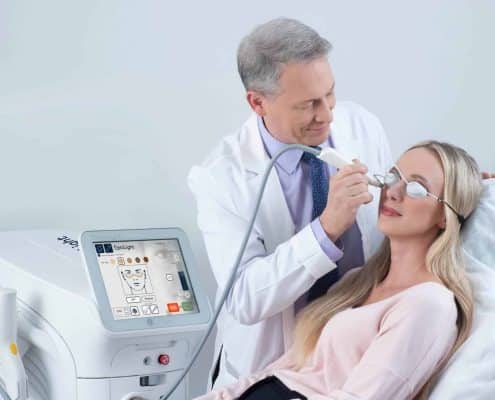OPTILIGHT BY LUMENIS

Dry eye is a common condition affecting around 20 million Americans. It can affect people of all ages, but the risk of dry eye increases as people age. Having dry eyes increases the risk of light sensitivity and blurry vision. It can also cause the eyes to sting, burn, or itch. Many people describe a scratchy feeling as if something is in their eyes. This condition has many potential causes but few treatments. OptiLIGHT by Lumenis is a proven treatment option that helps many people who have dry eyes and the discomfort from this common condition.
What is OptiLIGHT Treatment?
OptiLIGHT by Lumenis is a dry eye treatment that uses lights to stimulate the meibomian gland to better produce oil and tears. Specifically, this treatment uses intense broad-spectrum light to gently target the underlying cause of meibomian gland dysfunction, which is the cause of over 80% of dry eye disease cases.
This treatment uses patented Optimal Pulse Technology (OPT) to effectively and precisely target the right part of the eye, without undue risk and with highly effective results.
How Does OptiLIGHT by Lumenis Work?
Meibomian Gland Dysfunction has multiple potential causes. Sometimes, abnormal blood vessels in the tissue below the eye prevents proper gland production. Demodex mites, a common condition leading to dry eye, can also be a contributing factor. Sometimes, inflammation of the tissue around the eye is the common cause. OptiLIGHT addresses all of these.
OptiLIGHT works by sending targeted light into the tissue to reduce inflammation markers. This process helps the meibomian glands work more effectively while also delaying the evaporation of the tear film layer, helping your eyes stay moisturized longer.
What Should I Expect from OptiLIGHT Treatment
If your eye doctor thinks you are a good candidate for OptiLIGHT treatment, you can expect to have around four sessions spaced two to four weeks apart for your treatment. When you arrive, your eye doctor will cover the eyes with protective eyewear, then apply a thin layer of gel to the area just below your eyes, which is the treatment area. Your practitioner will then treat the area using the light therapy. Finally, before you leave, they may perform meibomian gland expression.
Risks and Side Effects from OptiLIGHT Treatment
One of the reasons OptiLIGHT treatment is such a good choice is its low risk of side effects, but there are still some potential issues that can develop. Sometimes, the skin texture in the treatment area can change or get damaged, and scarring is possible. Particularly fragile skin may bruise or burn. Some patients experience edema that does not go away. However, for most patients, the treatment causes no side effects and minimal discomfort.
Immediately after treatment, patients often have some redness in the area, but this resolves within a few hours. Adding makeup can cover it. Patients will need to avoid direct sunlight for a few days after treatment to avoid burning.
Is OptiLIGHT Therapy Right for You?
If you suffer from dry eye and do not have underlying eye conditions or serious immunosuppressive diseases, you are likely a good candidate for this treatment. However, only your eye doctor can determine if your dry eye is the right type to respond well to this treatment. Reach out to an eye doctor at Kingsley Family Vision Care today to see if OptiLIGHT by Lumenis is right for you.


